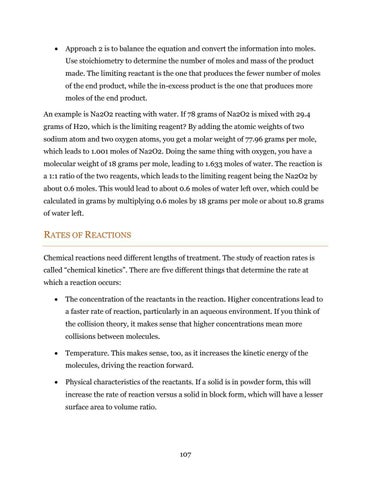•
Approach 2 is to balance the equation and convert the information into moles. Use stoichiometry to determine the number of moles and mass of the product made. The limiting reactant is the one that produces the fewer number of moles of the end product, while the in-excess product is the one that produces more moles of the end product.
An example is Na2O2 reacting with water. If 78 grams of Na2O2 is mixed with 29.4 grams of H20, which is the limiting reagent? By adding the atomic weights of two sodium atom and two oxygen atoms, you get a molar weight of 77.96 grams per mole, which leads to 1.001 moles of Na2O2. Doing the same thing with oxygen, you have a molecular weight of 18 grams per mole, leading to 1.633 moles of water. The reaction is a 1:1 ratio of the two reagents, which leads to the limiting reagent being the Na2O2 by about 0.6 moles. This would lead to about 0.6 moles of water left over, which could be calculated in grams by multiplying 0.6 moles by 18 grams per mole or about 10.8 grams of water left.
RATES OF REACTIONS Chemical reactions need different lengths of treatment. The study of reaction rates is called “chemical kinetics”. There are five different things that determine the rate at which a reaction occurs: •
The concentration of the reactants in the reaction. Higher concentrations lead to a faster rate of reaction, particularly in an aqueous environment. If you think of the collision theory, it makes sense that higher concentrations mean more collisions between molecules.
•
Temperature. This makes sense, too, as it increases the kinetic energy of the molecules, driving the reaction forward.
•
Physical characteristics of the reactants. If a solid is in powder form, this will increase the rate of reaction versus a solid in block form, which will have a lesser surface area to volume ratio.
107
